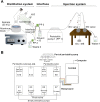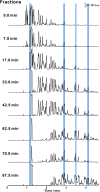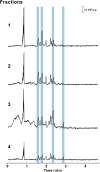Prototype of an Interface for Hyphenating Distillation with Gas Chromatography and Mass Spectrometry
- PMID: 28337400
- PMCID: PMC5359752
- DOI: 10.5702/massspectrometry.S0061
Prototype of an Interface for Hyphenating Distillation with Gas Chromatography and Mass Spectrometry
Abstract
Chemical analysis of complex matrices-containing hundreds of compounds-is challenging. Two-dimensional separation techniques provide an efficient way to reduce complexity of mixtures analyzed by mass spectrometry (MS). For example, gasoline is a mixture of numerous compounds, which can be fractionated by distillation techniques. However, coupling conventional distillation with other separations as well as MS is not straightforward. We have established an automatic system for online coupling of simple microscale distillation with gas chromatography (GC) and electron ionization MS. The developed system incorporates an interface between the distillation condenser and the injector of a fused silica capillary GC column. Development of this multidimensional separation (distillation-GC-MS) was preceded by a series of preliminary off-line experiments. In the developed technique, the components with different boiling points are fractionated and instantly analyzed by GC-MS. The obtained data sets illustrate dynamics of the distillation process. An important advantage of the distillation-GC-MS technique is that raw samples can directly be analyzed without removal of the non-volatile matrix residues that could contaminate the GC injection port and the column. Distilling the samples immediately before the injection to the GC column may reduce possible matrix effects-especially in the early phase of separation, when molecules with different volatilities co-migrate. It can also reduce losses of highly volatile components (during fraction collection and transfer). The two separation steps are partly orthogonal, what can slightly increase selectivity of the entire analysis.
Keywords: distillation; gas chromatography; gasoline; hyphenated techniques; online sample preparation.
Figures








Similar articles
-
Research on the separation properties of empty-column gas chromatography (EC-GC) and conditions for simulated distillation (SIMDIS).Anal Bioanal Chem. 2013 Oct;405(25):8377-82. doi: 10.1007/s00216-013-7236-z. Epub 2013 Aug 8. Anal Bioanal Chem. 2013. PMID: 23925798 Free PMC article.
-
Comprehensive gas chromatography-time-of-flight mass spectrometry using soft and selective photoionization techniques.Anal Chem. 2006 Sep 15;78(18):6364-75. doi: 10.1021/ac060531r. Anal Chem. 2006. PMID: 16970310
-
Steam distillation/drop-by-drop extraction with gas chromatography-mass spectrometry for fast determination of volatile components in jujube (Ziziphus jujuba Mill.) extract.Chem Cent J. 2017 Oct 13;11(1):101. doi: 10.1186/s13065-017-0329-6. Chem Cent J. 2017. PMID: 29086878 Free PMC article.
-
[Progress in the application of preparative gas chromatography in separating volatile compounds].Se Pu. 2023 Jan;41(1):37-46. doi: 10.3724/SP.J.1123.2022.04013. Se Pu. 2023. PMID: 36633075 Free PMC article. Review. Chinese.
-
Ion mobility spectrometry detection for gas chromatography.J Chromatogr A. 2008 Jan 4;1177(1):12-27. doi: 10.1016/j.chroma.2007.10.110. Epub 2007 Nov 12. J Chromatogr A. 2008. PMID: 18067900 Review.
References
-
- 1) J. G. Speight. Handbook of Petroleum Product Analysis. Wiley, Hoboken, 2002.
-
- 2) D. Yergin. The Prize: The Epic Quest for Oil, Money & Power. Free Press, New York, 2008.
-
- 3) A. M. Hochhauser. Gasoline and other motor fuels. Kirk-Othmer Encyclopedia of Chemical Technology 12: 386–435, 2014.
-
- 4) A. Y. El-Naggar, M. M. Al Majthoub. Study the toxic effects of aromatic compounds in gasoline in Saudi Arabia petrol stations. Int. J. Chem. Sci. 11: 106–120, 2013.
-
- 5) J.-Z. Zhang, J. Jin. The influence of common plastics on the identification of gasoline studied by GC-MS. Procedia Eng. 71: 372–376, 2014.
LinkOut - more resources
Full Text Sources
Other Literature Sources
Miscellaneous

